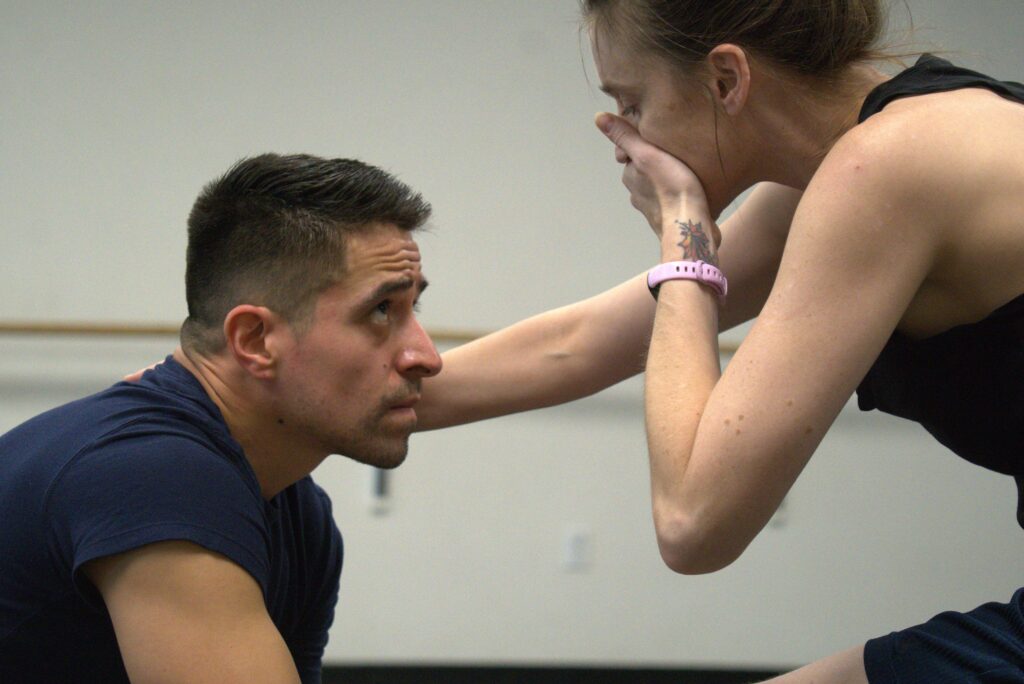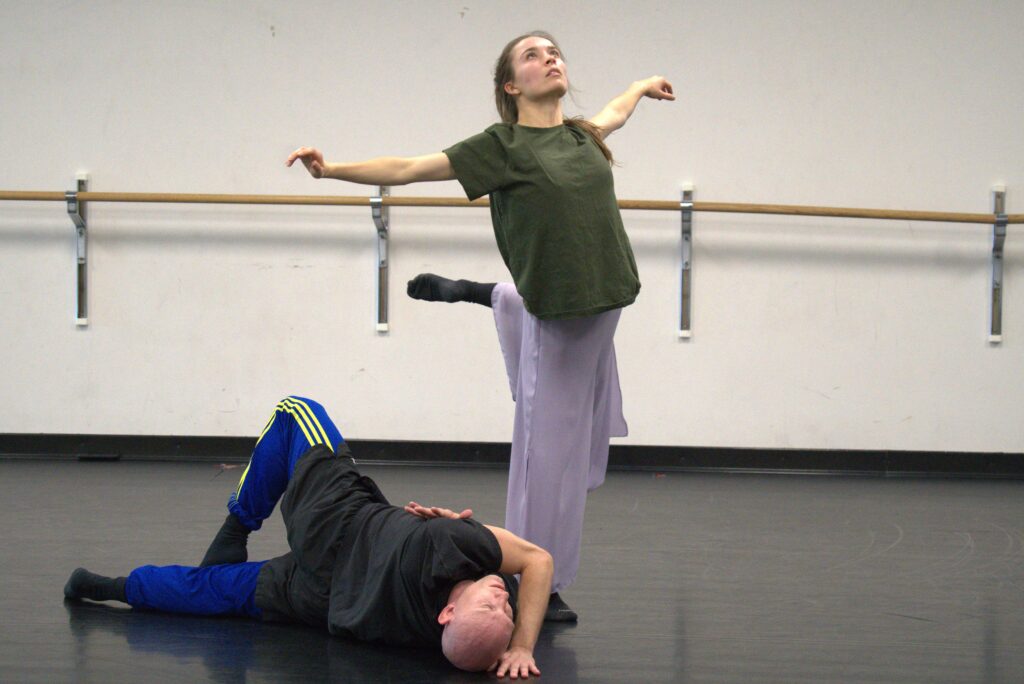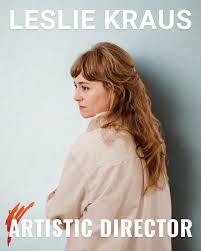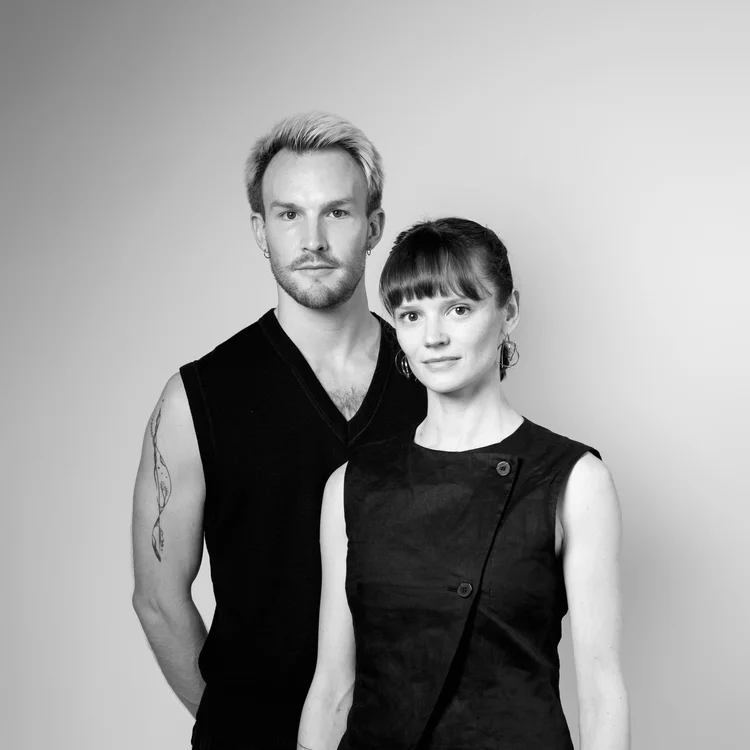The first lines in the new chapter of Ririe-Woodbury Dance Company’s history will be written this weekend when the company opens its 62nd season with Reverberation. Along with the reprise of Keith Johnson‘s A Century, A Day, which the company premiered in 2024, there will be two premieres: one by Leslie Kraus, the company’s new artistic director, and the other by FLOCK, the renowned German-American dance company founded by choreographers Florian Lochner and Alice Klock. The season also is dedicated to the memory of cofounder Shirley Ririe, who died this summer at the age of 96.
Kraus, a former principal dancer and assistant director with the Kate Weare Company and an associate professor at the University of Oklahoma’s School of Dance, becomes the company’s fourth artistic director and follows the legacy established by founders Joan Woodbury and Shirley Ririe. Selected from among some 50 candidates who came not just from the U.S. but also from Slovakia, Australia and the United Kingdom, Kraus immediately enthralled the search committee during her Zoom interview, Thom Dancy, executive director, noted. From 2020 to 2025, Kraus coordinated the Five Moons Dance Festival, which honors and celebrates the legacies of the five renowned Native American ballerinas from Oklahoma. Kraus also is a director for CONCRETE, an immersive theater intensive under Stefanie Batten Bland, the artistic director.
Kraus’ husband is Salt Lake native and former Ririe-Woodbury dancer Brandin Steffensen, and, in an interview with The Utah Review, Kraus said that his memories of his experiences as a performer with the company have helped to deepen her knowledge about its extraordinary history. “I also am fortunate to have among my friends a few artistic directors who have given me sage advice,” she said, adding that it is important in transitions to stay patient and consider how the process is like planting a tree.” Thus, Kraus is sensitive to the roots of the company’s mission, starting with its reputation for high standards of artistry and craft already earned during its early years as an experimental house for dance in the Utah area.

In Listening Hour, the first work that Kraus is setting on the company’s dancers, her process started with a deep dive into watching not only their body language and movement but also listening to them. Ririe-Woodbury dancers have consistently impressed choreographers and audiences not just for how quickly they become tightly knit even when newcomers join them but also for how mutually confident and comfortable they feel about allowing their unique personalities to come through on stage. Furthermore, it is the appreciation of the artist’s individuality not the attempt to reshape dancers into cookie-cutter form that primes the landscape for the collaborative dialogue that generates the most impactful experience between choreographers and dancers set to perform a specific piece. Warren Realrider, a native musician and sound designer with whom Kraus has worked in Oklahoma, will provide the score for Listening Hour.
Glitter by Flock’s principals Florian Lochner and Alice Klock will be the apt complement to Listening Hour. In an interview with The Utah Review, Klock said that the core of the piece centers around the occasional tensions and challenges one might encounter when they strive to be magical in their creative world. “Sometimes, being the sparkly creative type can cause conflict, especially when you realize that you’re not always being supported by others in the world around you,” she explained.

Klock and Lochner use a high caliber energy approach in their choreography. Klock and Lochner forged their collaboration as dancers and choreographic fellows at Hubbard Street Dance Chicago and created FLOCK in 2017. Their most recent international tours have included their evening-length productions Somewhere Between (named one of Chicago Tribune’s top 10 shows of 2023). They have choreographed for multiple dance companies, universities, and cultural institutions, including Hubbard Street Dance Chicago, Whim W’Him, GroundWorks DanceTheater, Backhausdance, Orsolina 28, Ballet Idaho, University of Michigan, Seattle Dance Collective, the Goethe Institut, the Alonzo King LINES Ballet BFA, and the 92nd Street Y. Every year they create a new work for the Freilichtspiele Schwäbisch Hall in southern Germany where they are company in residence.
When Klock and Lochner were part of this summer’s Dance West faculty in Salt Lake City, they began setting Glitter on the Ririe-Woodbury Dancers. “With Leslie’s [Kraus] playful energy, the company had the ideal landscape to build something to fit them with the certain magic that each one of them brings instead of coming in with a preconceived idea,” Klock said.
Lochner said that they started by talking about their initial thoughts about magical creatures such as unicorns. “This makes it emotionally visceral to watch them not as a group of clones but rather as individuals who are encouraged to have enough freedom to choose things to do, which not a lot of companies really have,” he explained. Thus, the choreographers watched their eyes and subtle facial emotions just as closely as they did in understanding how they move their bodies.
The work starts with a solo dancer as a magical unicorn (incidentally, featuring company newcomer Cody Brunelle-Potter). Eventually, the five other dancers encroach upon the soloist before splitting into a duet that is a counterpoint to the same material of the opening section. “There are very subtle differences in the choreography but it still follows the same script,” Klock explained. “All of the dancers come into the magical meeting space and they then split.” At this point, the company’s current senior dance artist, Megan McCarthy — or, as Klock whimsically refers to as ‘Megan Thee Stallion’ — stands out in her confidence, presence and strength, before the others try to hold or constrain her, thereby signifying the tensions that can occur when trying to support one another. A darker episode ensues, contemplating the tradeoffs and price that comes when one pursues their unique path as a magical being. The piece ends just as it begins, with a solo (danced by Sasha Rydlizky), but this time with the magic tempered by a bittersweet tinge.
Glitter is set to tracks of music by harpist Mary Lattimore and Apparat (Sascha Ring), a German electronic musician, which, respectively, parallel the shifts evolving in sections of the choreography. As for costuming, both Klock and Lochner said they were delighted that dancers Brunelle-Potter and Luke Dakota Zender selected layers of fabrics in various colors to match the mood board and suit individual representations of magical creatures. “For us, it was very special to work with Leslie [Kraus], just as she was getting started in her first season,” Lochner said, “and we are thankful to her for providing such a supportive playground and for the opportunity to go as weird as we wanted to go with our magical creature story.”
Equally apropos for the Reverberation theme of the season opener, it is the legacy of Ririe and Woodbury that inspired Johnson to set his eight-minute work A Century, A Day. In a 2024 interview with The Utah Review, Johnson talked about how the work symbolizes “a lot of windows” in various relationships involving “two people who had a powerful impact on my career.” Among them include the relationship he observed between Woodbury and her daughter, Jena, who retired two years ago from the company’s executive director post.
Intertwined with this theme are Johnson’s artistic reflections upon a career that spans more than 40 years, including the period of 1986-1994 when he danced with the company. Among the many works he said were significant during his tenure at Ririe-Woodbury are signature parts of the company’s repertoire, including works by Alwin Nikolai, Ririe’s Sheepherder’s Saga and To Have and To Hold by Shapiro and Smith, to name a few.
Now in his mid-sixties, Johnson, who moved from gymnastics to contemporary dance, also is sensitive to the demands a dancer’s body absorbs when choreographers set movement that is athletic and physically rigorous. “I talked about this with the dancers,” he said, adding that his experiences with aches and conditions in his ankle, shoulders and neck along with hip replacement surgery heightened the sense of responsibility a choreographer has when they ask dancers to execute hyper-physical movement and the price that dancers later pay with their bodies. As a result, for this work, Johnson said he “stripped things down to make it impactful without asking dancers to do something that might be hyper-physical.” Likewise, the dancers became integral in the collaborative process unfolding in the studio when Johnson was in Salt Lake City when he set the work.
Johnson was a latecomer to dance, starting at the age of 22, and within six months, he decided to audition for a spot in the company. While he didn’t land the job the first time, he was feeling, as he recalled, “iffy about more schooling because he already felt that he had enough of it.” Both Ririe and Woodbury persuaded him to pursue his master of fine arts degree at The University of Utah.
With his eight years at the company, he said the entire experience felt, in the best way, like a “10-year MFA program,” because he learned how to choreograph, how to teach dance and to articulate the power and importance of incorporating the arts in education. Incidentally, for his new work, he has selected music by Takashi Yoshimatsu, a Japanese composer who is best known for works based in the Western classical tradition, which also incorporate Japanese instruments at times, and who was influenced by jazz and rock as well. Johnson said he found common ground with Yoshimatsu, who dropped out of university and joined an amateur band, which was inspired by the music of Pink Floyd, before later beginning a career as a composer.
“It was an incredible opportunity to have Joan [Woodbury] and Shirley [Ririe] as mentors, because they pushed, challenged and questioned everything,” he explained. “Of course, there were some tensions and some periods were rough, but they encouraged me [and others] to find our own voices.” Looking back, Johnson said he now recognizes just how strong and important their influences were, adding, “I will always be in debt to them for their guidance in my dance career, as well to the dancers with whom I danced during my time there.”
Performances of Reverberation will take place Sept. 25-27 at 7:30 p.m. in the Leona Wagner Black Box Theatre at the Rose Wagner Center for Performing Arts. For tickets and more information, see the Ririe-Woodbury website.



